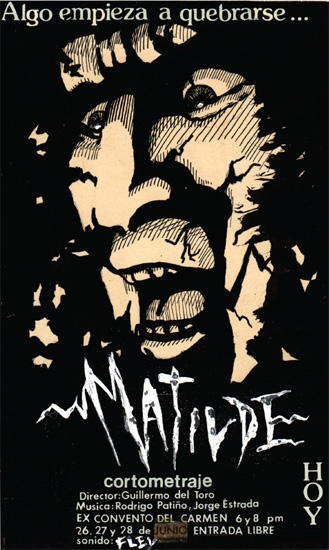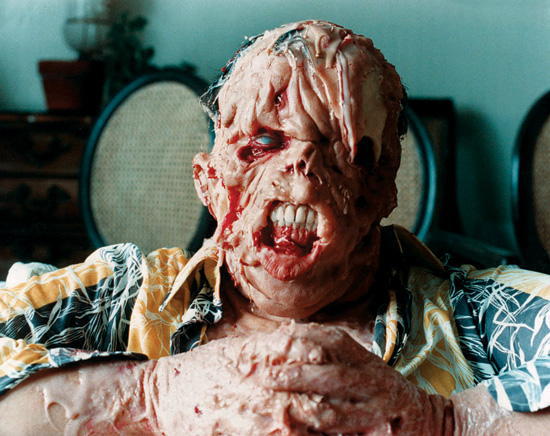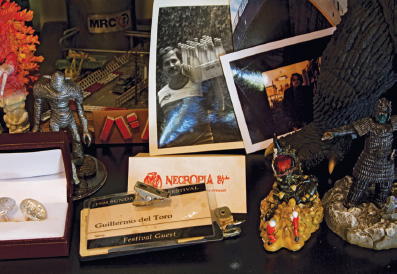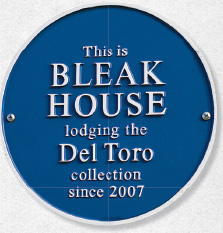
Del Toro shooting his short film Geometría with his Mitchell camera.

A poster promoting Matilde, one of del Toro’s short films, featuring art and typography by the director.

Del Toro wearing sculpted and molded gelatin makeup, including fake hair and acrylic dentures and gums.

A business card from del Toro’s special effects company Necropia S.A. de C.V., surrounded by other mementos.
From age eight on, Guillermo also began making short films. Around age twenty, he fell under the tutelage of filmmaker Jaime Humberto Hermosillo, for whom Guillermo served as executive producer on Doña Herlinda and Her Son (1985), which starred Guillermo’s mother, Guadalupe. (Hermosillo saw Guadalupe in a short film Guillermo made; he thought she was a good actress and cast her in her only feature film role.)
A key piece of advice from Hermosillo was to have faith in oneself. He would often tell Guillermo, “If a road is not presented, you build one.” Embracing this advice, Guillermo worked for ten years to establish Necropia, a special effects and makeup company in Mexico, a country that previously had no such facility. Necropia provided the makeup effects for his first feature, Cronos, in 1993.
Running through all Guillermo’s work like the hum of a high-voltage current is fear, the menacing, cold beauty of a knife’s edge. Rod Serling once observed, “The greatest fear of all is fear of the unknown, which you can’t share with others.” Nevertheless, Guillermo has explored and shared that fear with millions, his films evoking a sense of communal isolation on a grand scale.
Guillermo’s films are most easily defined as horror or dark fantasy, but not of the exploitative or escapist type. Instead, he crafts a particular brand of fear-tinged fantasy that interprets the world we live in, rather than offering a separate time or place where the audience might luxuriate in imaginative denial. As Guillermo observes, “When people say, ‘Oh, fantasy’s a great escape,’ I reply, ‘I don’t think so.’ Fantasy is a great way of deciphering reality.”
Guillermo utilizes the tools of fantasy and horror to open our eyes, as a way to see the world in its totality. His films constantly play with the border between what can be seen and what remains invisible, tackling the literal and metaphorical implications of blindness and vision.
“Spiritual blindness and physical blindness, I’m afraid of both,” Guillermo says. Whether it’s the Pale Man of Pan’s Labyrinth, the Angel of Death in Hellboy II, or the other myriad characters who choose to see or not see what is right in front of them, Guillermo invites us to consider the conscious and unconscious choices we ourselves make.
Interestingly, while existential dread has been a major theme in Guillermo’s work, a different kind of fear attends his career. “The thing I’m most afraid of is success. The second thing I fear the most is failing. But I think success is more scary. I tell you, and I’m being completely honest—people may think this is PR or me bullshitting—but the day I didn’t win the Oscar for foreign film for Pan’s Labyrinth, I was happy. It’s not a reflection about the Oscar. Any prize that I don’t win fuels the fire, and every prize I win quenches it. I always say, when you’re young and unsuccessful, you don’t have the money, and if you’re not careful, when you’re old and successful, you don’t have the passion. To be put in either of those two positions is a tragedy. I think one of the toughest times in any man’s life is his twenties, because in your twenties you’re fiercely screaming who you are, but you have only half a notion of who you are. Then as you grow older, you whisper who you are, but people are closer to you, and they listen. By that time, you have half a notion, a quarter of a notion, of who you are. I think the tragedy is when you finally have all the people that you need surrounding you, and you have nothing left to say.”
For now, Guillermo’s fears have not materialized. He is a passionate artist working at the height of his abilities. At various times, Guillermo has stood at a creative crossroads, tempted by the sort of success he fears could lead to tragedy. But in each instance, he has drawn a line, claimed himself, seen past the illusory, and chosen his voice, his calling, his singular form of expression.
In building the edifice of his life and work, it’s only natural that he’d erect a structure to hold his dreams and creations—a place called Bleak House.

The upstairs hallway at Bleak House, cluttered with framed art, books, and sculptures. The collection grows daily and is periodically rearranged by del Toro.
AT HOME
As I approached Bleak House for the first time, a house with an oddly Gothic air located in a subdivision outside of Los Angeles, I couldn’t help thinking of the opening lines to one of Edgar Allan Poe’s short stories:
During the whole of a dull, dark, and soundless day in the autumn of the year, when the clouds hung oppressively low in the heavens, I had been passing alone, on horseback, through a singularly dreary tract of country; and at length found myself, as the shades of the evening drew on, within view of the melancholy House of Usher.
I had come to Bleak House to begin the series of conversations that would form the foundation of this book. The sky was slate and intermittently rainy, and as I drew near the door, the rambling edifice towered over me, the storm clouds sweeping across the dragon weather vane like a leprous hand.
I regarded the heavy iron knocker like Marley’s ghost, raised it, and struck three times. A moment later, the thick oak door swung wide. There stood Guillermo.

The name plate that adorns the exterior of Bleak House.
“Come in, come in.” His big hand waved me inside.
Across the threshold, I found myself in a realm of wonders. In the foyer was what appeared to be an enormous figure of Sammael, the outrageous demon from Hellboy. To my left was apparently an antique oil of Saint George killing the dragon, to my right busts of Uncle Creepy and Cousin Eerie. Gleaming wood detailing flanked walls incarnadined as if infected by the mysterious plague from Poe’s “The Masque of the Red Death.” There was a life-size figure of the pinhead from Freaks and of Karloff’s Frankenstein, plus samurai armor, automata old and new, and the skulls and skeletons of creatures real and imagined. And in every square inch, filling room upon room, were framed insects and original art by Arthur Rackham, Bernie Wrightson, Edward Gorey, Drew Struzan, and Basil Gogos, along with first editions of Twain, Dickens, L. Frank Baum, and Andrew Lang, plus rare treatises on magic, the occult, and vampirism, on the monstrous and the dream-born.
It is a collection Guillermo describes as “every book I ever read and most every toy I ever bought,” all of it as meticulously designed as a Tiffany egg. Bleak House is Xanadu, if Charles Foster Kane had been thirteen years old and the most brilliant geek ever.